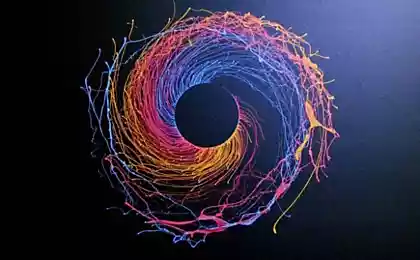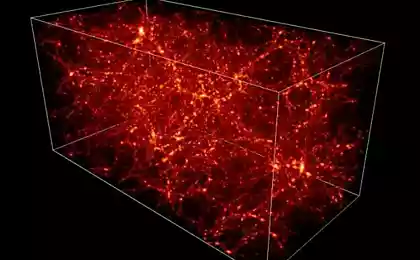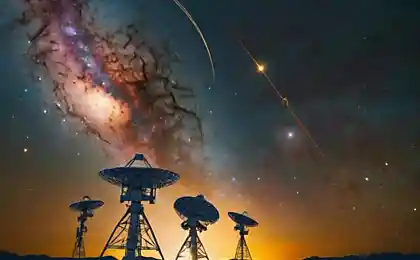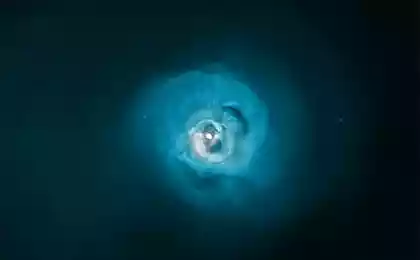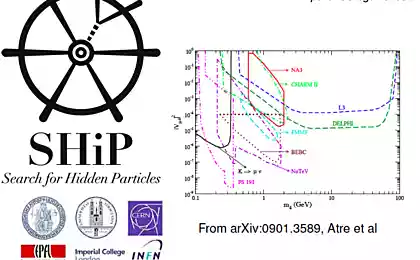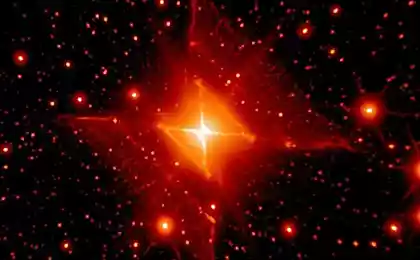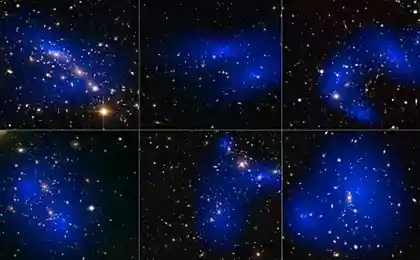559
The hunt for dark matter
Sorry for the poor physicists looking for dark matter is an exotic substance that makes up about a quarter of all matter in space, interacting with the rest of the Universe only through gravity and the weak interaction. And hardly a week goes by without a new hint of dark matter is not teased physicists, originating on the border of statistical error, and then disappeared, breaking their hopes.
Searches for dark matter put a huge amount of experiments, the whole alphabetical soup of acronyms, and each uses its own techniques and technology. So physicists have to search for something, the exact properties of things unknown to them. The problem is that although several experiments have detected possible hints of dark matter, they are inconsistent with each other. If you put the results of different experiments with different colors on one chart, it will look like abstract art.
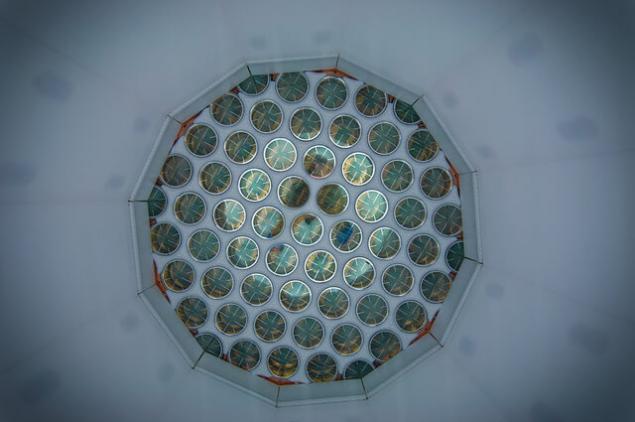
6 years ago Juan collar from the University of Chicago was full of hope about the imminent discovery of dark matter. But each subsequent result, it seemed, pointed in a new direction. No wonder his report he begins, slightly to paraphrase "the Big Lebowski": "We are nihilists, we believe in nothing".
"The last few years it seems that we are chasing our tails," said Kolar in an interview.
The good news is that something might be afoot again. Physics see the signs in the heavens and deep underground, and looking for other signs in the Large hadron Collider, which is also involved in the hunt for dark matter. Whispers of dark matter becomes louder and more signals seem to begin to converge. The bad news is that these hints still do not agree, and each of them is too unreliable, says Catherine Zurek [Kathryn Zurek] from the University of Michigan. Many physicists are skeptical of the fact that signs of dark matter in General can be found. Some even are addicted to nihilism, as Kolar said, "it's Hard not to be a nihilist given the fact how the events will develop".
The mysterious matterof Ordinary visible matter – the planets, stars, galaxies, and everything else – is only 4.9% of everything in the Universe. Most of it, in 68.3% is dark energy responsible for the accelerating expansion of the cosmos. The rest of 26.8% is composed of dark matter.
If physicists don't know exactly what dark matter is, its existence they believe. The concept originated in 1933, when Fritz Zvika analyzed the velocities of galaxies within the cluster and came to the conclusion that the gravitational attraction exerted by visible matter, can't keep a galaxy moving at high speeds, the generation of clusters. Decades later, Vera Rubin and Kent Ford found another proof of the "dark matter" Zvika, watching the stars spinning at the edge of galaxies. The stars had to move more slowly the farther they are spaced from the center of galaxies, as well as the outer planets of our Solar system slowly orbits around the Sun. Instead, the outer stars were moving as fast as the stars that were closer to the center, but the galaxy was falling apart. Something to complement the gravitational pull.
Dark matter was not the only explanation. May have been required to correct Einstein's model of gravity. It was suggested many alternative models, such as MOND (modified Newtonian dynamics). Ruby herself was once inclined to it, and said in an interview in New Scientist in 2005 that "it was more appealing than a universe filled with a new type of subnuclear particles."

The total mass of galaxies clusters of the Bullet is much smaller than the mass of two clouds cluster consisting of hot gas emitting x-rays (marked in red). The blue region, more massive than all the galaxies and clouds together, show the distribution of dark matter
But the nature side of our aesthetic preferences. In 2006, a striking image of the Bullet cluster (1E 0657-56) put an end to this issue. It was seen two clusters of galaxies passing through each other, and their gases collide, creating a shock wave in a bullet. The results of the analysis were surprising: the hot gas (ordinary matter), accumulated in more dense formations in the center, where there was a collision, and on the other hand accumulated what could only be dark matter. When confronted accumulations of dark matter passed right through, as she rarely interacts with ordinary matter.
"I think at this stage we can be confident in the existence of dark matter," says Dan Hooper, a physicist from the University of Chicago. "As far as I know, none of the modified theory of gravity doesn't explain it".
One leading candidate for dark matter particles – the class of weakly interacting massive particles, WIMP similar to another subatomic particle, the neutrino, which rarely interacts with other matter. After the discovery of the Higgs boson over one era of particle physics, and the public attention moves to a new major discovery. Cosmologist Michael Turner of the University of Chicago said that he believes the decade decade WIMP.
Signal/noiseMost theorists initially was leaning towards a variant with a heavy WIMP, and believed that dark matter consists of particles with mass of order 100 GeV. The masses of subatomic particles are measured in units of mass-energy, electron-volts. For example, the mass of a proton is 1 GeV. But recent evidence seems to support the option of light particles, which mass is in the range of 7 to 10 GeV. Because of this, register them directly is difficult because many of the experiments rely on measuring the recoil of the nucleus.
Such experiments are normally conducted deep underground in order to better filter out cosmic rays, which can easily be confused with dark matter signals. They are attended by a detector with carefully selected target material, such as germanium or silicon crystals, or liquid xenon. Then physicists expect occasional collisions of dark matter particles and atomic nuclei of the target material. This should lead to the appearance of flashes of light, and if they are bright enough, they will record the detector.
This means that for the detection of particles of dark matter it must carry enough energy to the collision with the nucleus to provide a signal exceeding the threshold sensitivity of the detector. And light WIMP will make it less likely. Neal Weiner of new York University says that the difference in the scenarios of WIMP is the same as the difference between the collision of two bowling balls and ping-pong with a bowling ball. "Kinetically heavy particle is much easier to carry this energy than light," he says.
As physicists looking for dark matter? Look at the bursts in the data collected by the detectors. The signal strength is determined by the number of statistical standard deviations, or Sigma, from the expected background values. This metric is often compared with a coin falling on tails several times in a row. The result is three Sigma is a big hint, equivalent to a fall of one side of the coin nine times in a row.
Many of these signals are attenuated or disappear, becoming statistically less important with the advent of new data. The gold standard for opening – five Sigma, the equivalent of the confluence 21 tails in a row. If several people simultaneously throw coins, and everyone falls tails several times in a row or do a few experiments to find the signal in the three-Sigma mass in the same interval – even an unlikely result, it becomes possible.
Some of the hints of dark matter are in a tricky area of 2.8 Sigma. "These promising results can be rejected for a week, said Matthew Buckley from the National accelerator laboratory. Enrico Fermi (Fermilab). – But these things always begin with a hint. When you collect more data, the hint becomes more statistically significant".
Background noise complicates the task. "Are you looking for "signal". "Background" is everything else that resembles your signal and makes it difficult to search," wrote Matthew Cash, a physicist from Rutgers University, in a blog in July 2011. He later added: "Unless you consider a small background, then it usually will come out in the form of additional low-energy collisions, which will be very easy to recall WIMP. In other words, light dark matter look the same as the incorrect signal".
Cash compared the task of trying to find a group of people in a crowded room. If your friends are wearing identical bright red jackets, and all the rest – clothes of other colors, finding the signal is easy. If other people will also wear bright red jackets, the random clusters of strangers will hide the signal. Imagine that you misjudged the number of people in red jackets, or even that you're colorblind. In any of these cases you will make the wrong conclusion: that you found your friends, when in fact the signal will be a random crowd of strangers.
The evidence todayin Spite of these problems, various experiments have led to some promising, albeit inconsistent, results. More than ten years ago the experiment DAMA/LIBRA (dark matter searches with detectors on the potassium iodide with added thallium), located deep in the mountains of Gran Sasso d'italia in Central Italy, found small fluctuations in the number of collisions per year. A group of scientists claimed to have detected a particle of dark matter in the form of a light WIMP with a mass of about 10 GeV.
DAMA/LIBRA
Other physicists have expressed serious doubts. Although the signal at DAMA/LIBRA really was, it could be evidence of something else. Not helped by the fact that in another experiment, XENON10, located in the bowels of the same mountain, and failed to detect signal in the same energy interval. The same happened with the CDMSII experiment conducted in a deep mine in Soudan, Minnesota. Both of the latter experiment was sensitive enough to detect the signal energy if the result of the DAMA/LIBRA do would be to dark energy.
Another experiment, CRESST, recorded the signal. But it is not fully consistent with the signal from DAMA/LIBRA, and its analysis failed to take into account all possible background noises that could simulate the desired signal. In addition, DAMA/LIBRA has caused irritation of the scientists, refusing to share the obtained data with the public, so that they could learn more.
When discussing the differences between experiments often, passions. "It happens that you make a report about the dark matter, and everything ends in a fight," says Buckley.
But the result of an Italian group of scientists has been quite stable. Kolar, along with other outspoken critics, has decided to prove the fallacy of the discoveries DAMA/LIBRA, organizing the experiment, called CoGeNT. In 2011, this plan collapsed because preliminary analysis of the CoGeNT data confirmed the results.
"We have built a CoGeNT, with the intention to expose DAMA, and now all of a sudden stuck in the same parameter space," says Kolar. However, because of a fire in the mine of the Sudan, in which the experiment original findings obtained with data spanning a period of just 15 months. And they show one signal at 2.8 Sigma. Now the Colar team analyzes data obtained for all three and a half years of the experiment, which should increase the signal – if it's real.

The CoGeNT Experiment
Doubts have not gone away. Results from CDMSII shows three events from the same area at 10 GeV. In the two years before that CDMSII there were two events similar to the dark matter, but after careful analysis they rejected. At this time, "we had three clear events," says Zurek.
"If anyone has seen dark matter, then it would look like exactly," she says. But due to the fact that they are still at the turn of the 2.8 Sigma, "nobody will believe that these three events happened due to the dark matter until it sees someone else." The latest evidence has prompted physicists from XENON10 to reconsider their analysis, and conclude that they mistakenly rejected hints on light WIMP detected in DAMA/LIBRA.
Suddenly, the light version of WIMP is at least plausible, and is supported by Hooper performed by analysis of gamma rays emitted from the center of our milky way, showing hints of a dark matter signal, corresponding to the variant 10 GeV.
But this is not the only option. WIMP with no interesting dynamics – no matter what weight they are just the easiest option for dark matter. There can be several types of dark matter particles, with different types of interactions through the dark forces, constituting a "dark sector" of the Universe which the theorists are only beginning to explore. Weiner believes that the model with dark powers – "the most straightforward way to explain some of these anomalies", but warns that before the experimental demonstration is still far. Zurek agrees: "In principle, we can record any number of theories, but nature will need to choose only one," she says.
When will we be able to know whether all these hints? Maybe in a year, maybe will have to wait much longer. However, physicists trying to find dark matter, may soon stumble upon more pragmatic constraints: budget cuts. It is important to search for a variety of experiments. "Since we don't know what particle physics dark matter interacts with normal, several different experiments to minimize the chances of missing dark matter because of the wrong choice, and if in a few experiments that will be detected can be discarded theoretical models much faster," said Buckley. However, all experiments are required to report the results to the Department of energy of the United States, and will be able to survive only 2-3 of them.
"The Department is imposing order, says Kolar. Diversity is good, but the amount of money is limited. If the construction of the detectors will not bring results, it will be very difficult to find the motivation to continue". published
P. S. And remember, only by changing their consumption — together we change the world! ©
Source: geektimes.ru/post/286072/
Searches for dark matter put a huge amount of experiments, the whole alphabetical soup of acronyms, and each uses its own techniques and technology. So physicists have to search for something, the exact properties of things unknown to them. The problem is that although several experiments have detected possible hints of dark matter, they are inconsistent with each other. If you put the results of different experiments with different colors on one chart, it will look like abstract art.

6 years ago Juan collar from the University of Chicago was full of hope about the imminent discovery of dark matter. But each subsequent result, it seemed, pointed in a new direction. No wonder his report he begins, slightly to paraphrase "the Big Lebowski": "We are nihilists, we believe in nothing".
"The last few years it seems that we are chasing our tails," said Kolar in an interview.
The good news is that something might be afoot again. Physics see the signs in the heavens and deep underground, and looking for other signs in the Large hadron Collider, which is also involved in the hunt for dark matter. Whispers of dark matter becomes louder and more signals seem to begin to converge. The bad news is that these hints still do not agree, and each of them is too unreliable, says Catherine Zurek [Kathryn Zurek] from the University of Michigan. Many physicists are skeptical of the fact that signs of dark matter in General can be found. Some even are addicted to nihilism, as Kolar said, "it's Hard not to be a nihilist given the fact how the events will develop".
The mysterious matterof Ordinary visible matter – the planets, stars, galaxies, and everything else – is only 4.9% of everything in the Universe. Most of it, in 68.3% is dark energy responsible for the accelerating expansion of the cosmos. The rest of 26.8% is composed of dark matter.
If physicists don't know exactly what dark matter is, its existence they believe. The concept originated in 1933, when Fritz Zvika analyzed the velocities of galaxies within the cluster and came to the conclusion that the gravitational attraction exerted by visible matter, can't keep a galaxy moving at high speeds, the generation of clusters. Decades later, Vera Rubin and Kent Ford found another proof of the "dark matter" Zvika, watching the stars spinning at the edge of galaxies. The stars had to move more slowly the farther they are spaced from the center of galaxies, as well as the outer planets of our Solar system slowly orbits around the Sun. Instead, the outer stars were moving as fast as the stars that were closer to the center, but the galaxy was falling apart. Something to complement the gravitational pull.
Dark matter was not the only explanation. May have been required to correct Einstein's model of gravity. It was suggested many alternative models, such as MOND (modified Newtonian dynamics). Ruby herself was once inclined to it, and said in an interview in New Scientist in 2005 that "it was more appealing than a universe filled with a new type of subnuclear particles."

The total mass of galaxies clusters of the Bullet is much smaller than the mass of two clouds cluster consisting of hot gas emitting x-rays (marked in red). The blue region, more massive than all the galaxies and clouds together, show the distribution of dark matter
But the nature side of our aesthetic preferences. In 2006, a striking image of the Bullet cluster (1E 0657-56) put an end to this issue. It was seen two clusters of galaxies passing through each other, and their gases collide, creating a shock wave in a bullet. The results of the analysis were surprising: the hot gas (ordinary matter), accumulated in more dense formations in the center, where there was a collision, and on the other hand accumulated what could only be dark matter. When confronted accumulations of dark matter passed right through, as she rarely interacts with ordinary matter.
"I think at this stage we can be confident in the existence of dark matter," says Dan Hooper, a physicist from the University of Chicago. "As far as I know, none of the modified theory of gravity doesn't explain it".
One leading candidate for dark matter particles – the class of weakly interacting massive particles, WIMP similar to another subatomic particle, the neutrino, which rarely interacts with other matter. After the discovery of the Higgs boson over one era of particle physics, and the public attention moves to a new major discovery. Cosmologist Michael Turner of the University of Chicago said that he believes the decade decade WIMP.
Signal/noiseMost theorists initially was leaning towards a variant with a heavy WIMP, and believed that dark matter consists of particles with mass of order 100 GeV. The masses of subatomic particles are measured in units of mass-energy, electron-volts. For example, the mass of a proton is 1 GeV. But recent evidence seems to support the option of light particles, which mass is in the range of 7 to 10 GeV. Because of this, register them directly is difficult because many of the experiments rely on measuring the recoil of the nucleus.
Such experiments are normally conducted deep underground in order to better filter out cosmic rays, which can easily be confused with dark matter signals. They are attended by a detector with carefully selected target material, such as germanium or silicon crystals, or liquid xenon. Then physicists expect occasional collisions of dark matter particles and atomic nuclei of the target material. This should lead to the appearance of flashes of light, and if they are bright enough, they will record the detector.
This means that for the detection of particles of dark matter it must carry enough energy to the collision with the nucleus to provide a signal exceeding the threshold sensitivity of the detector. And light WIMP will make it less likely. Neal Weiner of new York University says that the difference in the scenarios of WIMP is the same as the difference between the collision of two bowling balls and ping-pong with a bowling ball. "Kinetically heavy particle is much easier to carry this energy than light," he says.
As physicists looking for dark matter? Look at the bursts in the data collected by the detectors. The signal strength is determined by the number of statistical standard deviations, or Sigma, from the expected background values. This metric is often compared with a coin falling on tails several times in a row. The result is three Sigma is a big hint, equivalent to a fall of one side of the coin nine times in a row.
Many of these signals are attenuated or disappear, becoming statistically less important with the advent of new data. The gold standard for opening – five Sigma, the equivalent of the confluence 21 tails in a row. If several people simultaneously throw coins, and everyone falls tails several times in a row or do a few experiments to find the signal in the three-Sigma mass in the same interval – even an unlikely result, it becomes possible.
Some of the hints of dark matter are in a tricky area of 2.8 Sigma. "These promising results can be rejected for a week, said Matthew Buckley from the National accelerator laboratory. Enrico Fermi (Fermilab). – But these things always begin with a hint. When you collect more data, the hint becomes more statistically significant".
Background noise complicates the task. "Are you looking for "signal". "Background" is everything else that resembles your signal and makes it difficult to search," wrote Matthew Cash, a physicist from Rutgers University, in a blog in July 2011. He later added: "Unless you consider a small background, then it usually will come out in the form of additional low-energy collisions, which will be very easy to recall WIMP. In other words, light dark matter look the same as the incorrect signal".
Cash compared the task of trying to find a group of people in a crowded room. If your friends are wearing identical bright red jackets, and all the rest – clothes of other colors, finding the signal is easy. If other people will also wear bright red jackets, the random clusters of strangers will hide the signal. Imagine that you misjudged the number of people in red jackets, or even that you're colorblind. In any of these cases you will make the wrong conclusion: that you found your friends, when in fact the signal will be a random crowd of strangers.
The evidence todayin Spite of these problems, various experiments have led to some promising, albeit inconsistent, results. More than ten years ago the experiment DAMA/LIBRA (dark matter searches with detectors on the potassium iodide with added thallium), located deep in the mountains of Gran Sasso d'italia in Central Italy, found small fluctuations in the number of collisions per year. A group of scientists claimed to have detected a particle of dark matter in the form of a light WIMP with a mass of about 10 GeV.
DAMA/LIBRA
Other physicists have expressed serious doubts. Although the signal at DAMA/LIBRA really was, it could be evidence of something else. Not helped by the fact that in another experiment, XENON10, located in the bowels of the same mountain, and failed to detect signal in the same energy interval. The same happened with the CDMSII experiment conducted in a deep mine in Soudan, Minnesota. Both of the latter experiment was sensitive enough to detect the signal energy if the result of the DAMA/LIBRA do would be to dark energy.
Another experiment, CRESST, recorded the signal. But it is not fully consistent with the signal from DAMA/LIBRA, and its analysis failed to take into account all possible background noises that could simulate the desired signal. In addition, DAMA/LIBRA has caused irritation of the scientists, refusing to share the obtained data with the public, so that they could learn more.
When discussing the differences between experiments often, passions. "It happens that you make a report about the dark matter, and everything ends in a fight," says Buckley.
But the result of an Italian group of scientists has been quite stable. Kolar, along with other outspoken critics, has decided to prove the fallacy of the discoveries DAMA/LIBRA, organizing the experiment, called CoGeNT. In 2011, this plan collapsed because preliminary analysis of the CoGeNT data confirmed the results.
"We have built a CoGeNT, with the intention to expose DAMA, and now all of a sudden stuck in the same parameter space," says Kolar. However, because of a fire in the mine of the Sudan, in which the experiment original findings obtained with data spanning a period of just 15 months. And they show one signal at 2.8 Sigma. Now the Colar team analyzes data obtained for all three and a half years of the experiment, which should increase the signal – if it's real.

The CoGeNT Experiment
Doubts have not gone away. Results from CDMSII shows three events from the same area at 10 GeV. In the two years before that CDMSII there were two events similar to the dark matter, but after careful analysis they rejected. At this time, "we had three clear events," says Zurek.
"If anyone has seen dark matter, then it would look like exactly," she says. But due to the fact that they are still at the turn of the 2.8 Sigma, "nobody will believe that these three events happened due to the dark matter until it sees someone else." The latest evidence has prompted physicists from XENON10 to reconsider their analysis, and conclude that they mistakenly rejected hints on light WIMP detected in DAMA/LIBRA.
Suddenly, the light version of WIMP is at least plausible, and is supported by Hooper performed by analysis of gamma rays emitted from the center of our milky way, showing hints of a dark matter signal, corresponding to the variant 10 GeV.
But this is not the only option. WIMP with no interesting dynamics – no matter what weight they are just the easiest option for dark matter. There can be several types of dark matter particles, with different types of interactions through the dark forces, constituting a "dark sector" of the Universe which the theorists are only beginning to explore. Weiner believes that the model with dark powers – "the most straightforward way to explain some of these anomalies", but warns that before the experimental demonstration is still far. Zurek agrees: "In principle, we can record any number of theories, but nature will need to choose only one," she says.
When will we be able to know whether all these hints? Maybe in a year, maybe will have to wait much longer. However, physicists trying to find dark matter, may soon stumble upon more pragmatic constraints: budget cuts. It is important to search for a variety of experiments. "Since we don't know what particle physics dark matter interacts with normal, several different experiments to minimize the chances of missing dark matter because of the wrong choice, and if in a few experiments that will be detected can be discarded theoretical models much faster," said Buckley. However, all experiments are required to report the results to the Department of energy of the United States, and will be able to survive only 2-3 of them.
"The Department is imposing order, says Kolar. Diversity is good, but the amount of money is limited. If the construction of the detectors will not bring results, it will be very difficult to find the motivation to continue". published
P. S. And remember, only by changing their consumption — together we change the world! ©
Source: geektimes.ru/post/286072/
Mini encyclopedia of psychological mujchinam
Everything that affects the brain affects the body equally.

